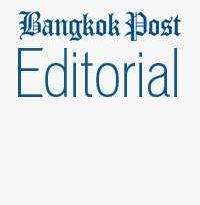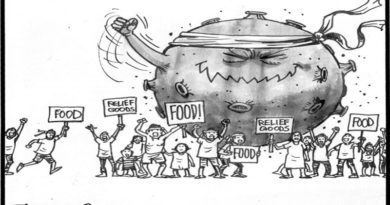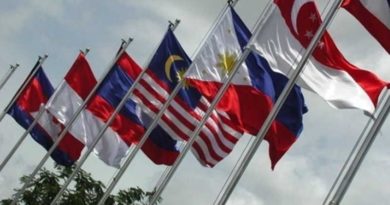Op-Ed: Column- OPINION ON PAGE ONE – A reversal of roles for Trump and Xi – are we ready for it? | BY FRANCISCO TATAD
THE Association of Southeast Asian Nations (Asean) is now 50 years old, and at least 20 world leaders are in town to help us celebrate its achievement. Asean as such is twice older than the 23-year-old European Union, which was established by the Maastricht Treaty in 1993, although its precursor, the European Economic Community, was created by the Treaty of Rome in 1957. Asean was first established by the foreign ministers of Indonesia, Malaysia, the Philippines, Singapore and Thailand in Bangkok on August 8, 1967, but it was only on December 15, 2008 that the Asean charter was formally launched in Jakarta as an economic organization, with the EU as its model.
From five original members, Asean quickly grew into a formidable group of 10, after Brunei became its sixth member, Vietnam its seventh, Laos and Myanmar its eighth and ninth, and Cambodia its 10th. East Timor and Papua New Guinea are waiting to become members. Asean has a land area of 4.4 million square kilometers, roughly three percent of the earth’s surface; waters three times more extensive than the land; a population of 625 million; and a gross domestic product (2015) of $2.8 trillion, sixth largest economy (taken as a single unit) after the US, China, Japan, France and Germany (Wikipedia). It has maritime borders with India, China, Palau and Australia; land borders with India, China, Bangladesh, East Timor and Papua New Guinea.
For its part, the EU began as the European Coal and Steel Community with six members—Belgium, France, Italy, Luxembourg, Netherlands and West Germany; grew into a powerful bloc of 28 member states with a combined land area of 4,475,757 square kms., a population of 510 million, and a GDP (2016) of $16.477 trillion (or 22 percent of the global GDP). Nineteen member states use the euro as their common currency, while 26, under the Schengen agreement, have abolished passport and other types of border control at their common borders. This means that a foreign traveler who has been allowed to enter any Schengen country may travel to any of the 25 other countries without need of a separate entry visa.
Asean grows, EU fractures
But while at least two other countries are seeking membership in the Asean, Britain, a most important, rich and powerful member of EU, voted in a referendum on June 23, 2016 to exit the EU. The referendum, called by British Prime Minister David Cameron, asked the voters whether they wanted to “leave” or “remain” in the Union. Leave won by 51.9 percent to 48.1 percent, with a turnout of 71.8 percent and more than 30 million voting. Cameron resigned, paving the way for the election of Prime Minister Theresa May, who is now negotiating the final steps toward Britain’s departure from the EU.
Asean was organized to promote cooperation, amity and non-interference among the five member countries and project “solidarity” against communist expansion in Vietnam and communist insurgency within their respective borders, at a time the Southeast Asia Treaty Organization (Seato) was already in decline. Established by the US, Britain, France, Australia, New Zealand, Pakistan, the Philippines and Thailand in September 1954, “to meet the common danger” in case of aggression against any signatory state, Seato had begun to fracture after France and Pakistan started to lose interest in the alliance. It finally expired on June 30, 1977. Despite its anti-communist motif, Asean did not get drawn into the Vietnam war. At war’s end,
Asean became a constructive force which helped to normalize relations between and among neighbors once caught up in territorial and ideological disputes. This was the case of Indonesia and Malaysia, against whom President Sukarno had launched the policy of confrontation; of Malaysia and the Philippines over the latter’s claim to Sabah; and of Vietnam and the US war allies. But Asean’s core interests have yet to be clearly defined.
A gala night
Last night, President Rodrigo Duterte hosted a gala dinner at the SMX Convention Center in Pasay City to pay homage to the golden anniversary, and honor the Asean heads of state and government and the 11 dialogue partners taking part in the 31st Asean summit and the other related summits today and tomorrow. As this was written hours before the dinner, I cannot say whether DU30 had anything to say about the vision and values of Asean. Presumably the Asean heads were all there.
These are Brunei’s Sultan Hassanal Bolkiah, Cambodian Prime Minister Hun Sen, Indonesian President Joko Widodo, Laos Prime Minister Thongloun Sisoulith, Malaysian Prime Minister Najib Razak, Myanmar State Counselor Aung San Suu Kyi, Singapore Prime Minister Lee Hsien Loong, Thailand Prime Minister Prayut Chan-o-cha, and Vietnam Prime Minister Nguyen Xuan Phuc.
The dialogue partners on the other hand are US President Donald Trump, Chinese Premier Li Keqiang, Japanese Prime Minister Shinzo Abe, Indian Prime Minister Narendra Modi, Russian Prime Minister Dmitry Medvedev, South Korean President Moon Jae-in, Australian Prime Minister Malcolm Turnbull, Canadian Prime Minister Justin Trudeau, European Council President Donald Tusk, New Zealand Prime Minister Jacinda Ardern, and UN Secretary General Antonio Guterres.
Two private groups—the Asean Business Advisory Council and the East Asia Business Council —will also “interface” with the 10 Asean heads. Presumably they were also at the dinner.
A wicked schedule
Aside from the 31st Asean plenary summit, which opens at 10 a.m. today, and the 12th East Asia summit, which gets under way at 1:30 p.m. tomorrow, there will be 13 other “summits” between the Asean 10 and the 11 dialogue partners. All meetings will be held at the Philippine International Convention Center in Pasay City, Metro Manila, rather than in Clark, Angeles City, Pampanga, as earlier announced.
Work and classes will be suspended in Metro Manila, the areas around the summit venues and the Northern Luzon Expressway (NLEX) will be on security lockdown, and Metro Manila and Clark will be no-fly zones for the duration of the summits. Vehicular traffic in Metro Manila, normally a nightmare for motorists and pedestrians alike, is expected to become much more vexatious.
It is the biggest gathering of world leaders in Manila in years. And one of the most perplexing conferences I have observed. The organizers have allotted no more than two hours each for the first day Asean plenary and the second day East Asia summit, and one hour and 15 minutes for each of the other 13 summits between the Asean 10 and the dialogue partners.
Within this limited time, Messrs. Trump, Li, Abe, Moon, Modi, Trudeau, Tusk, Guterres, and the two business groups are expected to squeeze in everything each of them would like to discuss with the 10. Unless the expected outcome has been pre-cooked at official or ministerial level, the heads of state and government might not be able to come up with anything worth announcing to the public or the press during these sessions.
The only certain result is the proposed signing of an Asean Consensus on the Protection and Promotion of the Rights of Migrant Workers before the formal closing of the summits, and the Philippines’ handover of the Asean chairmanship for next year to the Prime Minister of Singapore.
This appears to be a pet project of the Philippines, which is a major supplier of migrant labor to the rest of the world, and the product of much work at lower level before the current summits. So the signing is certain.
Will they last? More than this, it seems prudent to moderate one’s expectations. My greatest fear is that the summiteers may not have all the stamina and endurance. Some of them may not be as strong and healthy as their host to be able to withstand 15 “summits” in two days while simultaneously fighting their jet lag. Having participated in some summits and international conferences for years, I can say I have not seen an international conference schedule as tightly packed as this one.
This may seem a trivial concern, but I assure you it is not. And we have not even begun to consider the possible surprises from any of the participants. To DU30, as host, we shall extend some special consideration, and not nitpick on him, aside from asking him what happened to his announced plan to talk to Chinese President Xi Jinping in Danang, Vietnam about China’s continued island-making in the Spratlys. But we must keep a close eye on the biggest player, Mr. Trump.
In his speech before the Korean national assembly in Seoul, Trump unleashed his most potent sound and fury on North Korea’s strongman Kim Jong-un, accusing him of nearly every crime in the book. He described North Korea as a hell nobody deserved to live in. In return, a Pyongyang mouthpiece branded him a “mad dog.” In Beijing, he tried to cajole President Xi to solve his North Korean problem for him, pouring on the most profuse praise that seemed to debase the mere listener.
As a candidate, Trump had accused China —fairly or unfairly—of committing every possible offense to destroy American industry, debase the US currency, and take away jobs from American workers. On this Asian trip, Americans at home, notably the liberal American press, expected him to deliver on his campaign promise. But they saw him saluting Xi instead for leading a country that had left the US “so far behind” and blaming it all on past US administrations and their “weak American trade policy.”
He did not breathe a word about human rights while paying homage to Xi, whom he tried to eulogize as a “very special man.” But once at the APEC Economic Leaders meeting in Danang, Vietnam, he accused unnamed countries of having stripped the US of jobs, factories and industries, and promised to put an end to these chronic trade abuses. But after he raged against alleged trade abuses against the US, and pledged to make “America First,” Xi took his turn to speak as the champion of globalization and world trade.
An exchange of roles
Globalization, he said, is an “irreversible historical trend.” However, the philosophy behind it should be “repurposed to be more open, more balanced, more equitable and more beneficial to all. We should support the multilateral trading regime and practice open regionalism to allow developing members to benefit more from international trade and investment.”
This was a familiar text we used to hear from the US President as leader of the “Free World.” Now it is the President of China saying it, while the American President is saying the exact opposite.
It sounds like one world as we knew it has ended, and a new one has taken its place. Are we all ready for it?
Courtesy: Manila Times | BY FRANCISCO TATAD | NOVEMBER 13, 2017
<>
NOTE : All photographs, news, editorials, opinions, information, data, others have been taken from the Internet ..aseanews.net | [email protected] |
For comments, Email to :
D’Equalizer | [email protected] | Contributor










